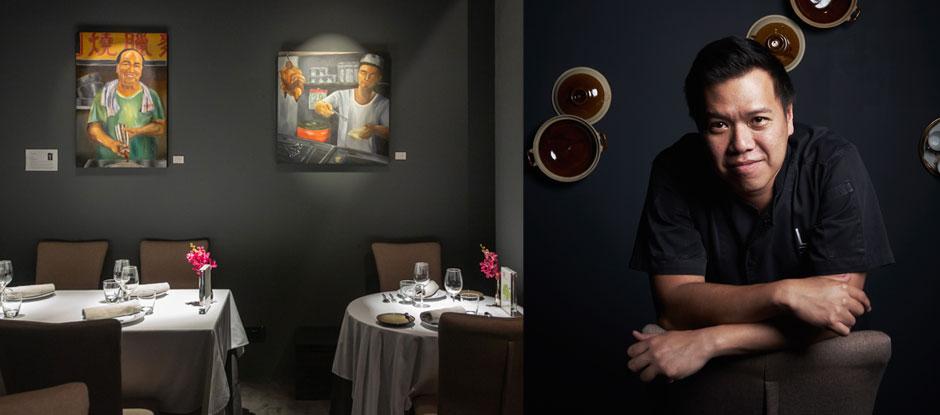An accidental encounter with native Singaporean produce in 2016 set chef LG Han on a chain of discoveries that led him to completely overhaul the concept of his restaurant Labyrinth. Five years later, the venue debuted on Asia’s 50 Best Restaurants 2021 and simultaneously received the Flor de Caña Sustainable Restaurant Award. Discover five key dishes that define the chef’s locavore journey and new-found purpose
A couple of years after he opened his modern neo-Singaporean restaurant in 2014, chef Han Li Guang – known as LG – was invited to take part in a local TV show. The premise was simple: a professional chef is paired up with an amateur cook to show them a few tips and tricks in the kitchen. Han’s partner for the show was to be a Singaporean fisherman.
“We took a boat to the fish farm,” he recalls. “During the pre-filming briefing, we were cooking chilli crab, the dish that would be shown in the programme. I asked the fisherman what crab we would be using on the show, and he said: ‘local flower crabs’.”
At this, Han laughed. It was 2016; ‘sustainability’ wasn’t yet the buzzwords it is today, where chefs all over the world are foregoing imported produce in favour of local, foraged and native ingredients. At this time, the only flower crabs that Han used at Labyrinth were imported from Indonesia and were used to make stocks, because the flavour was lacking and they didn’t have a lot of meat.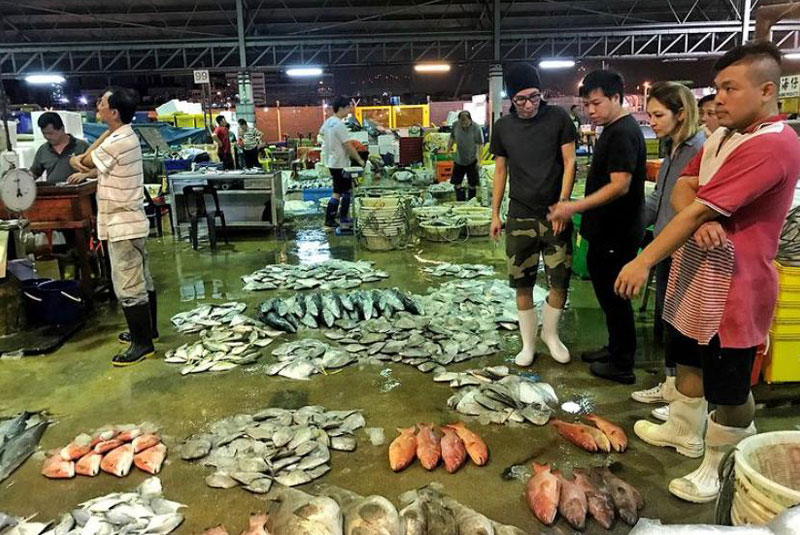
Han and his team at Singapore's fishery port
Han brought his own king crab along to the filming, but seeing the fisherman steaming and preparing the local flower crab, he decided to try it. “I was like, ‘shit!’ How does this taste so different from the ones from Indonesia? It was delicately sweet, had a taste of Singapore’s waters, a pleasant brininess, and the meat was juicy. I was ashamed and humbled. I started to ask the fisherman why. Then I told him: ‘show me more’.
“It wasn’t an eureka moment, but that day on the fish farm was when my eyes were opened. The fisherman explained to me how shellfish thrive in Singapore waters because of the higher salt level, and showed me how when fishing for crabs, they filter out the pregnant ones and throw them back in the sea. That’s sustainability. That set me on a hunt around Singapore. I went to meet vegetable farmers, goat farmers, I even stumbled across a crocodile farm,” says Han.
After two years of searching and painstaking R&D, the chef overhauled Labyrinth’s concept to showcase authentic Singaporean farm-to-table in 2018. Today, between 60 and 90% of all ingredients used at the restaurant come from within the Lion city, considered by many an urban jungle – but for Han, an endless source of culinary inspiration.
Watch the video with chef Han:
“At the end of the day, it’s really about how every dish at Labyrinth starts from an idea to support someone, like a farmer, or to promote a produce or an aspect of Singaporean culture or heritage before the dish is conceptualised,” suggests Han. “I want guests to know who I am, what I believe in and why Labyrinth exists. I think the restaurant has a lot of purpose, but I think we’re still only scratching the surface of Singapore’s potential.
“For me, the Flor de Caña Sustainable Restaurant Award means more than anything else. My guests, and sometimes even my team, don’t always understand why we’re not importing foie gras or using cheaper, frozen imported products. It’s going to be a long journey. Let’s hope it doesn’t take hundreds of years for sustainability to catch on globally. But if we don’t start right now, then what’s the point?”
Dive into five Labyrinth dishes that chart Han's own sustainable journey
1. Chilli Crab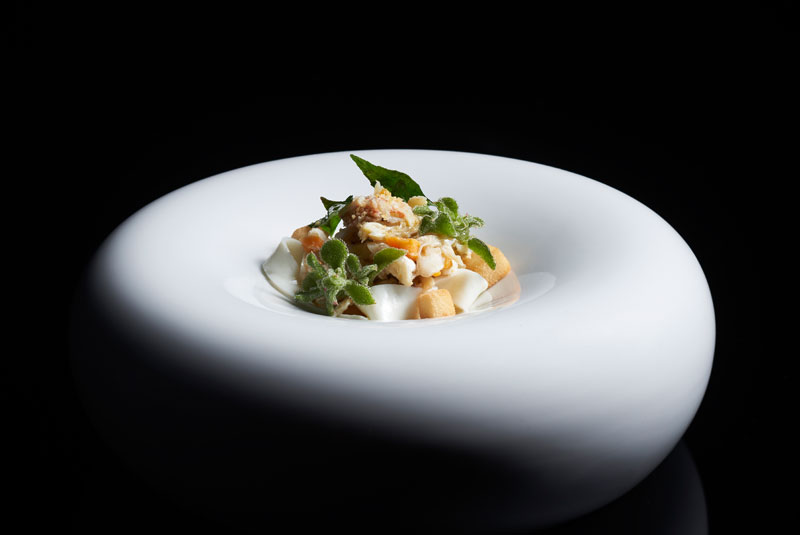
“When it opened in 2014, Labyrinth celebrated modernist techniques and molecular cuisine, which was trendy at the time,” says Han. But from the beginning, the chef’s personal rendition of the chilli crab – one of Singapore’s most emblematic dishes – was the signature. “Back then, the main premise was that I turned the sauce into a chilli tomato ice cream,” he says.
Now, instead, the focus is on the local, wild-caught flower crab – the same that inspired Han’s locavore journey. “We decided to hide the ice cream beneath the crab, so that guests eat it later. It’s the same creative process, but we reversed the focus: instead of customers focusing on a technique, they focus on the produce. The hope is that this will get them interested in where that product comes from. For me, it's very meaningful to change people's minds about how they see Singaporean produce.”
2. Yu Sheng 
Another classic Singaporean dish, yu sheng is a colourful salad typically eaten for Chinese New Year. “We call it ‘the prosperity salad’,” says Han. “As we eat it, we say eight sentences to bring good luck in the coming year. The Singaporean version was created by the four heavenly kings of Chinese cuisine – cooks who worked in the 1960s and 1970s – who came up with the current recipe and the idea of tossing the salad for good luck.”
Labyrinth’s version of yu sheng showcases the restaurant’s hyper-local sourcing philosophy, as well as highlighting Singaporean tradition and heritage. “The main star is a flower called ulam rajah, which tastes like green mango and naturally grows in the wild,” explains Han. “It was brought to Singapore from Portugal over 200 years ago, when sailors used to eat it as a super food to keep themselves going. It is beautiful, has a bit of crunch to it and a striking acidity with a hit of sweetness.
“Singaporeans have not yet reached a stage where they like to eat flowers – the ulam rajah often comes back to the kitchen uneaten, so we try to explain more about it when the dish is presented. The flower costs almost as much as the fish! The protein is a barramundi fish that is farmed offshore in Singapore. There is also pickled old cucumber, honey, a fermented tomato granita and Indian borage, a herb that is like the Asian version of a mint leaf – everything in the dish is local. For me, it’s important that guests open their eyes to something new and native.”
3. From the Soil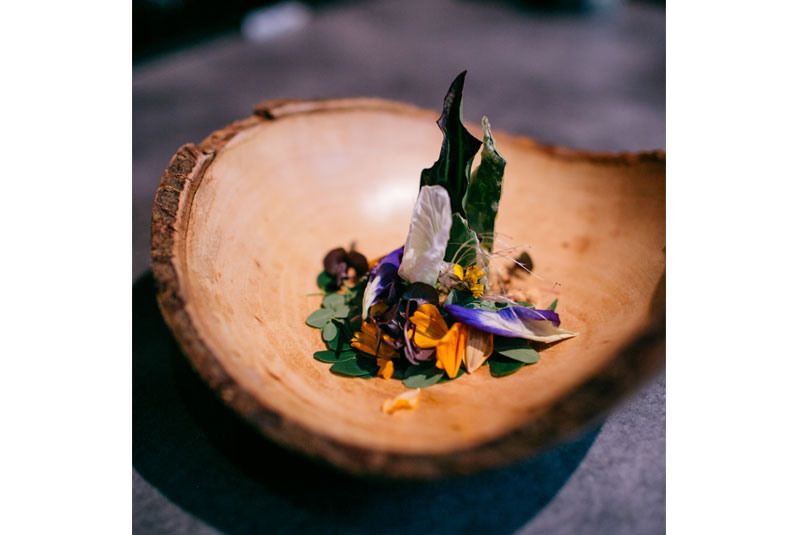
“This dish is my homage to the local farmers,” says Han. The chef sources most of the produce for Labyrinth from Singapore’s edible gardens. “These gardens were first set up not to make money, but to encourage community and to use the available spaces on rooftops or balconies to go green. The incredible thing is that they support autistic people by giving them jobs on the farm, and they also practice sustainability, using fly larvae to break down compost and then use it on the farm.
“I created this dish also to honour rojak [a traditional street food dish that originated in Malaysia]. People don’t expect so many herbs and vegetables to be grown in Singapore – it features 14 different ones and it’s made to look like a Singaporean garden.
“On the day of the Asia’s 50 Best Restaurants awards, I invited the farmers I work with to have dinner at Labyrinth and I served them this dish. They loved it because they saw their hard work in it, and they said it was delicious. I hope this dish does justice to their work on the farm. Their lives are not easy and seeing them happy and proud to have their vegetables served in the restaurant – it meant a lot to me.”
4. Tribute to the Kelong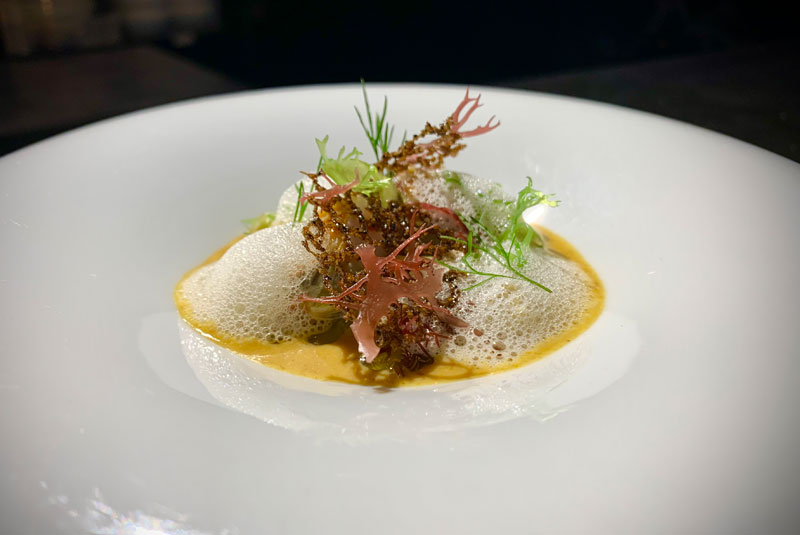
As well as edible gardens, Han sources much of Labyrinth’s ingredients from the kelongs, Singapore’s offshore fish farms. “When people ask me what’s my favourite local produce, I say the green lip mussels have to be one of my favourites,” he reveals. “They are a local breed, taste delicious, are juicy and grow naturally on the farm – you just drop a rope into the sea and a week later you have mussels.
“The dish also features neck clams, which are wild-caught in the Johore Strait between Singapore and Malaysia. Then there is a foam made from crab shells, and it is served with a laksa sauce, a traditional broth from the region. The dish is built to look like a fish farm, with a little net.
“The edible garden farmers and kelong fishermen are my two most trusted partners. We have built a relationship beyond just seller and buyer – we’re friends. Once, I needed some lobster for a VIP guest, and the fisherman drove three hours to his farm on a Sunday to bring me some locally caught rock lobster, then refused to charge me for it. He said: ‘We are brothers, you’ve already paid me more than enough by supporting and promoting me’. It was really touching.
“This makes my life as a chef gain a lot more purpose. Cooking for people and seeing happy customers is important, but so is seeing the producers appreciating what I'm doing for them and hopefully for Singapore as well. So this dish is for them.”
5. Native
It was chef Han’s innate curiosity that led to the creation of this unique dessert. “It features oyster plant, also known as Moses-in-the-cradle, a native Singaporean ingredient traditionally used to make tea – but I turned it on its head and made it into shaved ice. It is bright purple, which gives the ice this natural colouring. Then, one day I saw this weird plant growing on the roadside. I brought it to the edible garden farmer, who showed it to his uncle, the most senior farmer – it took about a month to find out what it was. It’s called wandering Jew.
“I went back to the restaurant, infused it in water and found it had a great synergy with the oyster plant. The roselle flower adds fruitiness to the dessert. The combination was very bright and refreshing. I paired it with aloe vera, local honey and tropical fruits. This dish is really about native herbs, about using what’s local to create natural flavours that have by now been forgotten. And who doesn’t like shaved ice, especially as it’s so hot in Singapore?”
The list of Asia's 50 Best Restaurants 2021, sponsored by S.Pellegrino & Acqua Panna, was announced on 25th March , via a virtual awards ceremony – visit the website to discover all the winners. To stay up to date with the latest news, follow us on Instagram, Facebook, Twitter and YouTube.
